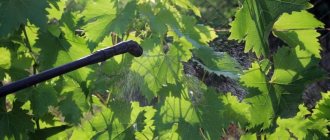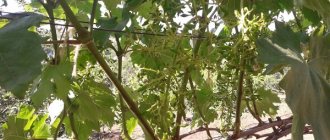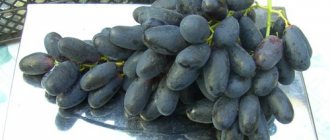Grapes have been grown since ancient times. This plant is famous not only for its taste, but also for its ability to create decorative structures in the garden. Grape fruits are an excellent raw material for compotes, juices, wine, not to mention the consumption of fresh berries. Grapes are widely used in cosmetology and medicine.
As a rule, the place for the vine in the garden is chosen next to the wall of the house or around the gazebos. You can use grapes to divide the territory into zones by making arches and pergolas. Arched grapes (look at the photo) are just such a variety with which you can create various architectural forms to decorate the garden.
Advantages and disadvantages
When deciding to grow the “arch” grape variety, it is important to familiarize yourself with its advantages and disadvantages in advance.
The main advantages of the variety:
- Impeccable taste.
- High content of useful microelements in fruits.
- Good fruitfulness and high yields.
- Early ripening.
- Frost resistance.
- Good keeping quality and transportability.
Also, the bushes are unpretentious in care and have decorative qualities, which allows them to be used, among other things, to decorate the site.
The variety has few disadvantages and they are associated with taste, which deteriorates due to the dense peel and the presence of large seeds inside the berries.
Preparing for winter
In the warm southern climate, Arch grapes are not covered in winter. The hybrid inherited good frost resistance from its parent forms. But the frosty winters of the Central zone are dangerous for it, so before the onset of frost the vine is removed from its support and laid on the ground.
For your information!
In the southern regions, it is enough to hill up the bush for the winter.
Until the snow falls, the lashes are covered with several layers of spunbond. In areas where there is little snow, spruce branches and roofing material are used to protect against frost. Arch grapes recover well after freezing.
Origin
“Arched” grapes are the result of breeding work by scientists at the All-Russian Research Institute of Winemaking and Viticulture named after. ME AND. Potapenko , located in Novocherkassk.
Parents of the arched one - “friendship” and “intervitis magarach”
The varieties Druzhba, characterized by frost resistance, early ripening and good immunity to diseases, and Intervitis magaracha, which is also characterized by resistance to frost and fungal infections, were selected as genetic material.
Reference! Among winegrowers, such names as “colored”, “pink friendship”, “III 14-1-1” and “flower arched” are also common.
A little history
The Arochny variety is a hybrid of Russian selection. The authors are scientists from the Russian VNIIViV named after. ME AND. Potapenko. In some sources, Arched has other names: III-14-1-1, Pink Friendship or Tsvetnoy. According to known information, the Intervitis Magaracha grape variety and the white-berry Druzhba grape variety were chosen for crossing.
Botanical properties
The vine of the Arch grape variety is vigorous and, with good care, reaches three meters. The variety is early ripening, frost-resistant. The grapes propagate well from cuttings. Having planted a vine, you can get the first harvest in the second year.
Not every gardener will risk making new plantings without knowing the details about the plant. Therefore, we will present to our readers a description with a photo of the Arochny grape variety. In this photo the plant is three years old.
Description of fruits
- Arochny's clusters are large, with medium-sized berries, their weight reaches 400-600 grams. They have a standard cylindrical-conical shape. The grapes are almost the same size; there are no peas on dense clusters.
- The berries measure 18x25 mm and weigh about 6 grams. The shape is oval-nipple. The color of the berries is interesting, flowing from pink to red. Especially bright, as gardeners write in reviews, are the fruits of the Arochny grape variety, growing on the sunny side.
- The pulp is juicy, tasty and aromatic. Tasters give the Arochny variety 7.7 out of 10 points.
- But not everyone likes the thick skin and large number of seeds of this grape variety.
- The berries contain enough sugar – 16-18%, acid – about 5 g/l.
Beneficial features
The description of the variety would not be complete if we did not talk about the beneficial properties of the grapes. Berries are rich in chlorine and sodium, sulfur and zinc, iodine and chromium, boron. In addition, they contain glucose, fructose, ascorbic acid and pectin.
By consuming the Arochny grape variety, you can:
- strengthen the immune system and normalize blood pressure;
- get rid of pain symptoms in the joints;
- forget about insomnia.
Doctors recommend fresh grape juice for many diseases.
In the photo: Arochny will soon be in time.
Main characteristics
The variety is characterized by stable yield - on average, one bush can produce 10-12 kg of berries. It is also worth noting such varieties as “anyuta”, “lily of the valley” and “transformation”.
Maturation period and class
“Archny” is an early-ripening grape variety; 110-120 days pass from the moment the buds set until the crop is ready for harvesting.
Bush
The bushes are vigorous, young shoots grow up to 3 m in length, fruitful shoots make up 65-80% of the total. A distinctive feature of the vine is its elasticity, thanks to which the shoots can be given any shape.
The leaves are large, serrated and bright green.
Bunches and berries
After flowering, up to 15-20 dense, medium-sized clusters are formed on each shoot. They have a conical or cylindrical-conical shape, and each weighs on average 400-600 g.
The berries are one-dimensional, oval-nipple in shape, grow up to 25 mm in length, 18 mm in width and weigh approximately 5-8 g.
The skin is thick and dense, at the beginning of ripening it has a yellowish-pink color, and by the time of harvest it becomes bright burgundy. The color depends on the degree of illumination of the fruits - the more sun they get, the stronger and more saturated their color. The pulp is juicy and aromatic, there are many fairly large seeds inside.
Fruit sugar content is 16-18%, acidity is 4-5 g/l. In addition, the berries contain iron, potassium, calcium, magnesium, phosphorus, manganese, chlorine, sodium, sulfur, zinc, iodine, chromium, boron and vitamins B and C.
Taste
The berries have a sweet taste with a pleasant floral flavor and aroma. However, the taste is slightly spoiled by the dense, astringent and sour skin and the presence of seeds, which give the grapes a grassy taste.
Description of the variety
Characteristics of the variety:
This is an early ripening variety - an average of 120 days is enough for its dense clusters weighing 400-600 grams to ripen.
Among the early ripening varieties, Zagrava, Bagrovy and Velika are also known.
Attractive pink berries have a rather pleasant, although not record-breaking delicacy (taster rating: 7.7 out of 10) sweet taste. The sugar content in them is 16-18%. The grapes are large, with thick skin.
The vine is vigorous, with large leaves.
The Arochny grape variety belongs to the early table hybrids. The variety is very productive, which is not surprising - the bush has great growth vigor, and 60-80% of its shoots are fruit-bearing. Young shoots ripen quickly and along their entire length, take root well, and easily tolerate grafting.
The Archny variety is early-fruiting; the first harvest ripens in the second year after planting in the ground. There is no need to rush into harvesting; the berries on the branch retain commercial quality and attractive appearance for a long time.
The Krasotka variety can also boast of early fruiting.
Gardeners often ask the question: How to prune arched grapes correctly? Pruning of lashes should be done at 6-8 buds.
Such varieties as Pink Flamingo, Beauty of the North and Super Extra can also boast of high frost resistance.
Photo of “Arochny” grapes:
Features of cultivation
Proper care is the key to healthy grapes and a high-quality and abundant harvest.
Landing
The most suitable time for planting arched grapes is the end of spring, warm May days. In this case, the hole in which the grapes will be planted should be prepared in the fall , this will allow the substrate in it to be filled with oxygen during the winter. In addition, the soil will have time to freeze well, which will help destroy harmful microorganisms.
“Arched” grape seedlings take root in any soil, but prefer sandy and sandy loam. In the first case, the drainage layer may not be used; in all others, it will not be possible to do without it.
Reference! Garden soil should be fertilized in advance by adding at least 2 buckets of humus, 0.5 buckets of ash and 0.5 kg of azofoska.
The bushes should be planted on the southwestern or southeastern side of the site, in a place where there are no tall trees nearby, since the “arched” one loves good light and sun.
You also need to monitor the groundwater level - the permissible depth is at least 2.5 m. The fact is that this grape variety has a developed root system that goes deep into the ground, and increased humidity will lead to rotting of the roots and will negatively affect the volume and quality of the harvest .
Watering and fertilizing
It is necessary to water the bushes weekly; depending on weather conditions, each bush will require 10-20 liters of warm, preheated or heated water in the sun. In August, when the grapes begin to prepare for winter, watering should be suspended. To moisten the soil, use a drainage and watering tube installed during planting.
To stimulate growth, development, improve decorative qualities and immunity, arched grapes must be regularly fed with mineral (potassium salt, ammonium nitrate, superphosphate and potassium chloride) and organic (bird droppings, manure, compost, peat) fertilizers.
Fertilizing should be done in early spring (immediately after removing the winter cover), 10 days before flowering, after the formation of clusters of berries, during the ripening of the crop and before preparing for winter.
Trimming
When pruning “arched” bushes, you should leave 2 lashes – fruiting and replacement. The first one needs to be cut to 5-8 buds, and the second one needs to be left with 2. Already in the next season, the replacement vine will become fruit-bearing and will need to be replaced by a younger one. This rotation is repeated annually.
Important! In the first season, it is forbidden to form and trim bushes; such procedures are permissible only for the 2nd year.
Diseases and pests
The “arched” grape variety is resistant to mildew and gray rot, but it can be affected by oidium (powdery mildew). Therefore, in order to prevent diseases, before the buds swell, the vine should be treated with a solution of copper sulfate, and if symptoms of infection appear on the shoots, with Bordeaux mixture.
Among the pests, root phylloxera is a danger to “arched” bushes.
Frost resistance
The variety has fairly high frost resistance and can tolerate air temperatures down to -25 °C. When growing in a southern climate, the bushes do not need to be covered, but if we are talking about the Central zone, then covering is required, especially if there is little snow in the winter.
Harvest storage
“Arched” storage option
After harvesting, the brushes need to be sorted out: those with some damage should be sent for processing, and intact and healthy ones should be placed in wooden boxes and stored in a dark, cool room with moderate humidity. In such conditions, the grapes are stored until January.
Regions
The “arched” grape variety is recommended for cultivation in mid-latitudes and northern regions.
Specifics of care
Watering is important for the first two years. A young plant needs moisture at least once a week. The water should be warm, in volume from 1 to 2 buckets per bush. Stop watering at the end of August.
Mature plants have a powerful root system that goes deep into the ground. With its help, the grape bush provides itself with moisture, so watering is rare. They are needed before flowering and while the clusters are forming.
Productivity increases if Arch grapes receive additional feeding. It responds well to the addition of organic matter. Every second year, the soil under the bushes is fertilized with humus (2 buckets per 1 plant), annually - 1-2 liters of ash.
Comparison with analogues
Let's compare the “arched” one with its main competitors.
| Sign | Variety | |||
| Arched | Attica | Fun | Libya | |
| Ripening period | 110-120 days | 115-120 days | 100-120 days | 105-110 days |
| Frost resistance | up to -25 °C | up to -23 °C | oo -21 °C | up to -21°С |
| Yield per bush | 12 kg | 15-20 kg | 25-30 kg | up to 30 kg |
| Bunches | 400-600 g | 700-900 g | 700-800 g | 800-1200 g |
| Taste | Floral | Sweet, with fruity notes of cherry, mulberry or chokeberry | Sweet, dessert, with cherry and plum aroma | nutmeg aroma |
| Color | Pink | Dark purple | Dark blue | pink |
| Disease resistance | Average | Average | High | average |
| Shelf life | Several months | Few weeks | A few months | up to 1 month |
| Sugar content | 16-18% | 16-18% | 16-18% | 18-23% |
| Acidity | 4-5 g/l | 5 g/l | 6 g/l | 6-7 g/l |
Photo
Below, see photos and reviews of the “arched” variety.
Reviews
The variety is productive and stable, resistant to diseases, and looks attractive in appearance. Very vigorous, just right for a gazebo. Elena Nikolaevna, Kyiv
To me, Archny tastes like grass. The bunches are not very large, and the berries are not very large either. Arthur Bormalaev, Moscow region
Arched has a marketable appearance, but the taste is mediocre. Quite an unpretentious variety, for sale. Ignatiy Pavlovich, Zhytomyr region.










